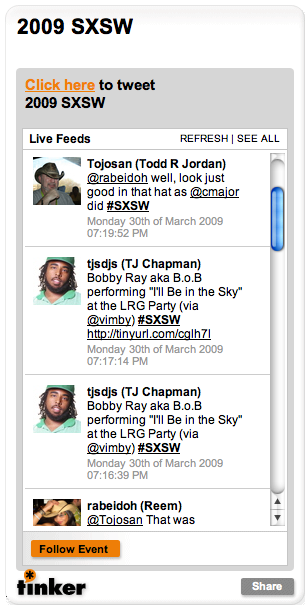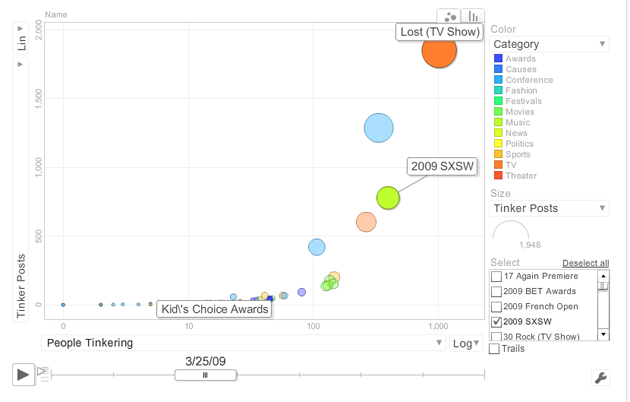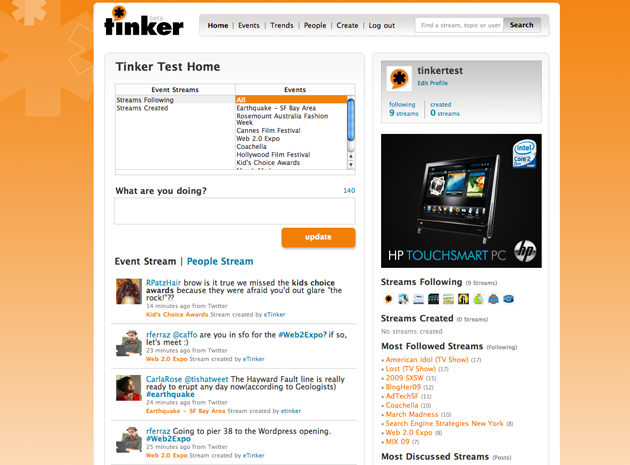Over a year ago Fred Wilson wrote about the need for a Twitter events firehose – a place where users could input a handful of keywords collectively referred to as an ‘event’, which could be used to monitor current news as it happens in near real-time. Tomorrow morning, he’ll get his wish when Glam Media launches a new service called Tinker to the public.
As its popularity has skyrocketed, Twitter has quickly become an indispensable tool for nearly any event, ranging from breaking news stories like the Mumbai terrorist attacks to the broadcast of the most recent episode of Dancing With The Stars. Major earthquakes are often reported by hundreds of Twitter users a matter of seconds after they’ve occurred.
Most people rely on Twitter Search and hashtags to keep tabs on these events, but these aren’t particularly efficient or user friendly. There have been a number of sites that have offered one-off Twitter pages for events, like the Presidential election and The Oscars. These are great, but there still hasn’t been an easy way to create similar pages for smaller events or breaking news stories. Tinker solves this problem, allowing users to build these pages in seconds. And it’s very well done, with a polished intuitive interface that may well make the site the de facto standard for Twitter events.
At a high level, each Tinker event can be described as a persistent search for multiple keywords on Twitter. Each Event is associated with one or more terms, which Tinker then searches for across all Tweets and presents in a single stream. For example, a Tinker Event for March Madness might present tweets that included the terms ‘NCAA’, ‘Basketball’, and ‘Final Four’.
At launch Tinker is going to allow normal users to create their own ‘Events’, but they’ll only be able to search for one key word, hashtag, or phrase at a time (they can also choose terms that they’d like to exclude). Trusted partners, such as those that are running an event, will be able to access a more robust interface, where they can include multiple queries in a stream (normal users will eventually be able to use the same functionality). And while these queries are currently limited to Twitter and FriendFeed for now, it wouldn’t be surprising if we saw Tinker open up to monitoring other services in the future.

The homepage is very well done, but Tinker’s real power will likely lie in its ability to go viral with widgets. After creating an Event, users can share the event’s feed using an embeddable widget, which they can place on their webpage or blog. These widgets allow users to both view the feed of an event and to submit their own messages, which can then be sent to Twitter and eventually sites like Facebook and FriendFeed. From an advertising perspective the widgets are also appealing, as they allow brands to pick out ‘trusted’ streams (for example, one with tweets only pertaining to the Oscars) that they’d like their ads to appear next to. Tinker will also post feeds created by trusted partners on its homepage, allowing the most established events to get more traction.
Some Twitter veterans might argue that Tinker isn’t really necessary to monitor an event – after all, hashtags originated for largely the same purpose. But hashtags come with their own issues (namely, you have to figure out exactly which hashtag everyone is using), and for Twitter novices hashtags can be a pretty difficult concept to grasp. On Tinker, they don’t have to deal with any of those issues – they simply sign on and click on the topic that they’d like to read about.
Aside from its text streams, Tinker has a number of very cool tools that can be used to monitor events. My favorite is Historical Trends, an interactive graph that plots out how ‘hot’ a given event is over time relative to any other event in the system. Users can watch how the ‘Lost’ event skyrockets to the top of the Twitter conversation on Wednesday nights, only to drop sharply the next day. Or they can watch as the SXSW event slowly faded from prominence to obscurity over the last week. It’s an impressive visualization, and one that could easily be used to map other keywords, like the name of a startup over time.
Tinker will be launching tomorrow morning to the public, and we’ll be sure to let you know as soon as it does.


